Table of Contents
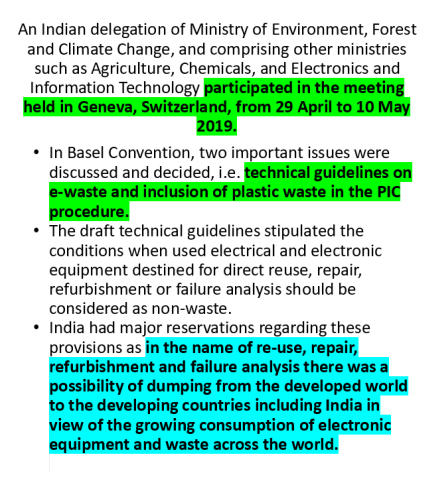
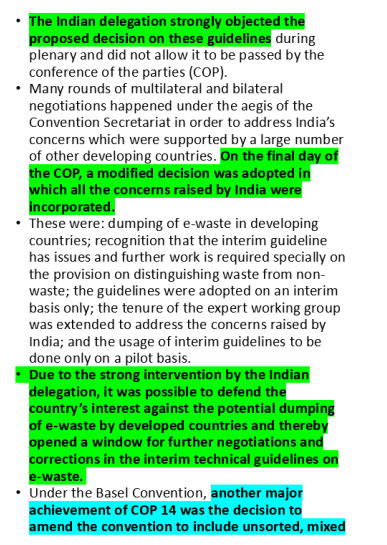
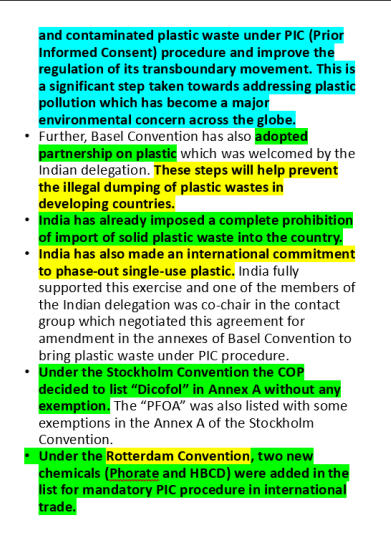
- Stockholm Convention on Persistent Organic Pollutants is an international environmental treaty, signed in 2001 and effective from May 2004, that aims to eliminate or restrict the production and use of persistent organic pollutants (POPs).
- In 1995, the Governing Council of the United Nations Environment Programme (UNEP) called for global action to be taken on POPs, which it defined as “chemical substances that persist in the environment, bio-accumulate through the food web, and pose a risk of causing adverse effects to human health and the environment”.
- Following this, the Intergovernmental Forum on Chemical Safety (IFCS) and the International Programme on Chemical Safety (IPCS) prepared an assessment of the 12 worst offenders, known as the dirty dozen. The INC met five times between June 1998 and December 2000 to elaborate the convention, and delegates adopted the Stockholm Convention on POPs at the Conference of the Plenipotentiaries convened from 22–23 May 2001 in Stockholm, Sweden.
- The negotiations for the Convention were completed on 23 May 2001 in Stockholm. The convention entered into force on 17 May 2004 with ratification by an initial 128 parties and 151 signatories. Co-signatories agree to outlaw nine of the dirty dozen chemicals, limit the use of DDT to malaria control, and curtail inadvertent production of dioxins and furans.
- Parties to the convention have agreed to a process by which persistent toxic compounds can be reviewed and added to the convention, if they meet certain criteria for persistence and transboundary threat. The first set of new chemicals to be added to the Convention were agreed at a conference in Geneva on 8 May 2009. As of June 2018, there are 182 parties to the Convention, (181 states and the European Union). Notable non-ratifying states include the United States, Israel, Malaysia, and Italy.
- The Rotterdam Convention (formally, the Rotterdam Convention on the Prior Informed Consent Procedure for Certain Hazardous Chemicals and Pesticides in International Trade) is a multilateral treaty to promote shared responsibilities in relation to importation of hazardous chemicals. The convention promotes open exchange of information and calls on exporters of hazardous chemicals to use proper labeling, include directions on safe handling, and inform purchasers of any known restrictions or bans. Signatory nations can decide whether to allow or ban the importation of chemicals listed in the treaty, and exporting countries are obliged to make sure that producers within their jurisdiction comply.
- In 2012, the Secretariats of the Basel and Stockholm conventions, as well as the UNEPpart of the Rotterdam Convention Secretariat, merged to a single Secretariat with a matrix structure serving the three conventions.
- The three conventions now hold back to back Conferences of the Parties as part of their joint synergies decisions.
- The seventh meeting of the Rotterdam Conference was held from 4 May to 15 May 2015 in Geneva, Switzerland.
- The Basel Convention on the Control of Transboundary Movements of Hazardous Wastes and Their Disposal, usually known as the Basel Convention, is an international treaty that was designed to reduce the movements of hazardous waste between nations, and specifically to prevent transfer of hazardous waste from developed to less developed countries (LDCs). It does not, however, address the movement of radioactive waste. The Convention is also intended to minimize the amount and toxicity of wastes generated, to ensure their environmentally sound management as closely as possible to the source of generation, and to assist LDCs in environmentally sound management of the hazardous and other wastes they generate.
- The Convention was opened for signature on 22 March 1989, and entered into force on 5 May 1992. As of October 2018, 186 states and the European Union are parties to the Convention. Haiti and the United States have signed the Convention but not ratified it
MCQ 1
- Perfluorooctanoic acid (PFOA) (conjugate base perfluorooctanoate) is a perfluorinated carboxylic acid produced and used worldwide as an industrial surfactant in chemical processes and as a material feedstock, and is known as an emerging health concern and subject of regulatory action and voluntary industrial phase-outs.it can be added to the food chain by
- Food
- Drinking Water
- Indoor Air
- Dust
- Food packaging
(A) 1,2,5
(B) 1 & 2
(C) 5 only
(D) All
MCQ 2
- Regarding EPFO choose correct :
- The Employees’ Provident Fund came into existence with the promulgation of the Employees’ Provident Funds Ordinance on the 15th November, 1951. It was replaced by the Employees’ Provident Funds Act, 1952 2.
- The EPFO is under the administrative control of Ministry of Finance, Government of India
- Choose correct
(A) Only 1
(B) Only 2
(C) Both
(D) None
- EPFO is one of the World’s largest Social Security Organisations in terms of clientele and the volume of financial transactions undertaken. At present it maintains 17.14 crore accounts (Annual Report 2015-16) pertaining to its members.
- The Employees’ Provident Fund came into existence with the promulgation of the Employees’ Provident Funds Ordinance on the 15th November, 1951. It was replaced by the Employees’ Provident Funds Act, 1952. The Employees’ Provident Funds Bill was introduced in the Parliament as Bill Number 15 of the year 1952 as a Bill to provide for the institution of provident funds for employees in factories and other establishments. The Act is now referred as the Employees’ Provident Funds & Miscellaneous Provisions Act, 1952 which extends to the whole of India except Jammu and Kashmir.
- The Central Board of Trustees administers a contributory provident fund, pension scheme and an insurance scheme for the workforce engaged in the organized sector in India.
- The Board is assisted by the Employees’ PF Organization (EPFO), consisting of offices at 135 locations across the country. The Organization has a well equipped training set up where officers and employees of the Organization as well as Representatives of the Employers and Employees attend sessions for trainings and seminars.The EPFO is under the administrative control of Ministry of Labour and Employment, Government of India
- The Act and Schemes framed there under are administered by a tri-partite Board known as the
- Central Board of Trustees,
- Employees’ Provident Fund, consisting of representatives of Government (Both Central and State), Employers, and
- Employees.
MCQ 3
- The Global Platform for Disaster Risk Reduction is a biennial multistakeholder forum established by the UN General Assembly to review progress, share knowledge and discuss the latest developments and trends in reducing disaster risk.
- is a critical component of the monitoring and implementation process of the Hyogo Framework for Disaster Risk Reduction (2015-2030).
- Choose correct
(A) Only 1
(B) Only 2
(C) Both
(D) None
Ministry of Home Affairs
- Dr P. K. Mishra presents Country Statement at Global Platform for Disaster Risk Reduction 2019 at Geneva, Switzerland
- A high level Indian delegation headed by Dr P.K. Mishra, Additional Principal Secretary to Prime Minister is participating in the Global Platform for Disaster Risk Reduction 2019 being held at Geneva, Switzerland from 13-17 May 2019.
- While presenting the Country Statement today, Dr Mishra briefed on the steps taken by India, after the adoption of the Sendai Framework.
- He mentioned that India is not only focusing on reducing mortality from major disasters but also from small or medium, and locallyspecific disasters such as heat wave, thunderstorm and lightning. Focussed attention and investments in cyclone risk mitigation has yielded dividends in saving precious human lives. Deaths during cyclone Phailin in 2013 and Fani in 2019 have reduced considerably.
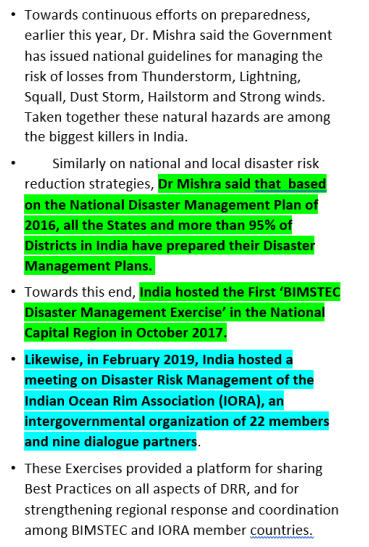
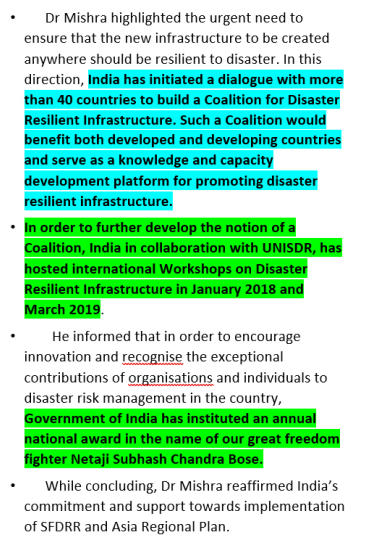
MCQ 4
- Rudraksha trees are found only in India
- Rudraksha is a seed traditionally used as a prayer bead in Hinduism (especially Vaishnavism). Rudraksha seeds are covered by a blue outer shell when fully ripe, hence also being called blueberry beads
- Their Medicinal properties are not mentioned.
- Choose correct
(A) Only 1
(B) 1 & 2
(C) All
(D) None
- Rudraksha seeds exhibit pharmacological properties that include anti-inflammatory, analgesic, sedative, antidepressant, antiasthmatic, hypoglycemic, antihypertensive, smooth muscle relaxant, hydrocholeretic, antiulcerogenic, and anticonvulsant.
- In Ayurveda, the bead, bark, and leaves of the rudraksha tree, which have antibacterial effects, are used for treating various ailments such as mental disorders, headaches, fever, skin diseases, etc. They are also used for treating cough, breathing problems, controlling epilepsy, liver-related problems, jaundice, stomach aches, high blood pressure, and treating burns, as well as improving memory power, controlling brain fever, and blood purification. The flesh or pulp of the drupe is administered for epilepsy, diseases of the head, and in mental illness
Ministry of Water Resources, River Development and Ganga Rejuvenation
MoU Signed for Rudraksh Plantation in Ganga Basin
- A Memorandum of Understanding (MoU) was signed between National Mission for Clean Ganga, HCL Foundation and INTACH for taking up a project of ‘Plantation of Rudraksh Trees in Uttarakhand’ as a part of CSR initiative under the ‘Namami Gange’ Programme.
- While the project aims at planting 10,000 Rudraksh trees in the catchment area of river Ganga in Uttarakhand in association with local community and other stakeholders, it will also help in generating income for people residing in those areas.
- The tripartite MoU was signed by representative from HCL Foundation, INTACH and Shri Rozy Agarwal, Executive Director (Finance) from NMCG on 14th May 2019 in the presence of Shri Rajiv Ranjan Mishra, Director General NMCG and Shri G. Ashok Kumar, Executive Director (Projects).
- Shri Rajiv Ranjan Mishra, Director General, NMCG said that Namami Gange Mission aims at providing comprehensive and sustainable solutions for a cleaner ecosystem along the stretch of 97 towns and 4,465 villages on the Ganga stem and a publicprivate partnership will provide the initiative a much-needed impetus. He congratulated HCL Foundation and INTACH for coming forward and joining hands with NMCG in this endeavour.
INDIAN NATIONAL TRUST FOR ART AND CULTURAL HERITAGE (INTACH)
- The Indian National Trust for Art and Cultural Heritage (INTACH) was founded in 1984 in New Delhi with the vision to spearhead heritage awareness and conservation in India.
- Today INTACH is recognized as one of the world’s largest heritage organizations, with over 190 Chapters across the Country. In the past 31 years INTACH has pioneered the conservation and preservation of not just our natural and built heritage but intangible heritage as well. Headquartered in New Delhi, it operates through various divisions such as Architectural Heritage, Natural Heritage, Material Heritage, Intangible Cultural Heritage, Heritage Education and Communication Services (HECS), Crafts and Community Cell, Chapters, INTACH Heritage Academy, Heritage Tourism, Listing Cell and Library, Archives and Documentation Centre.
MCQ 5
- Dichlorodiphenyltrichloroethane, commonly known as DDT, is a colorless, tasteless, and almost odorless crystalline chemical compound, an organochlorine, originally developed as an insecticide, and ultimately becoming infamous for its environmental impacts
- Dicofol is an organochlorine pesticide that is chemically related to DDT. Dicofol is a miticide that is very effective against spider mite.
- Choose correct
(A) Only 1
(B) Only 2
(C) Both
(D) None
- Dicofol is an organochlorine pesticide that is chemically related to DDT. Dicofol is a miticide that is very effective against spider mite.
- One of the intermediates used in its production is DDT. This has caused criticism by many environmentalists; however, the World Health Organization classifies dicofol as a Level II, “moderately hazardous” pesticide.It is known to be harmful to aquatic animals, and can cause eggshell thinning in various species of birds.
- Dichlorodiphenyltrichloroethane, commonly known as DDT, is a colorless, tasteless, and almost odorless crystalline chemical compound,an organochlorine, originally developed as an insecticide, and ultimately becoming infamous for its environmental impacts. It was first synthesized in 1874 by the Austrian chemist Othmar Zeidler.
- DDT’s insecticidal action was discovered by the Swiss chemist Paul Hermann Müller in 1939. DDT was used in the second half of World War II to control malaria and typhus among civilians and troops.
- Müller was awarded the Nobel Prize in Physiology or Medicine “for his discovery of the high efficiency of DDT as a contact poison against several arthropods” in 1948
DOWNLOAD Free PDF – Daily PIB analysis

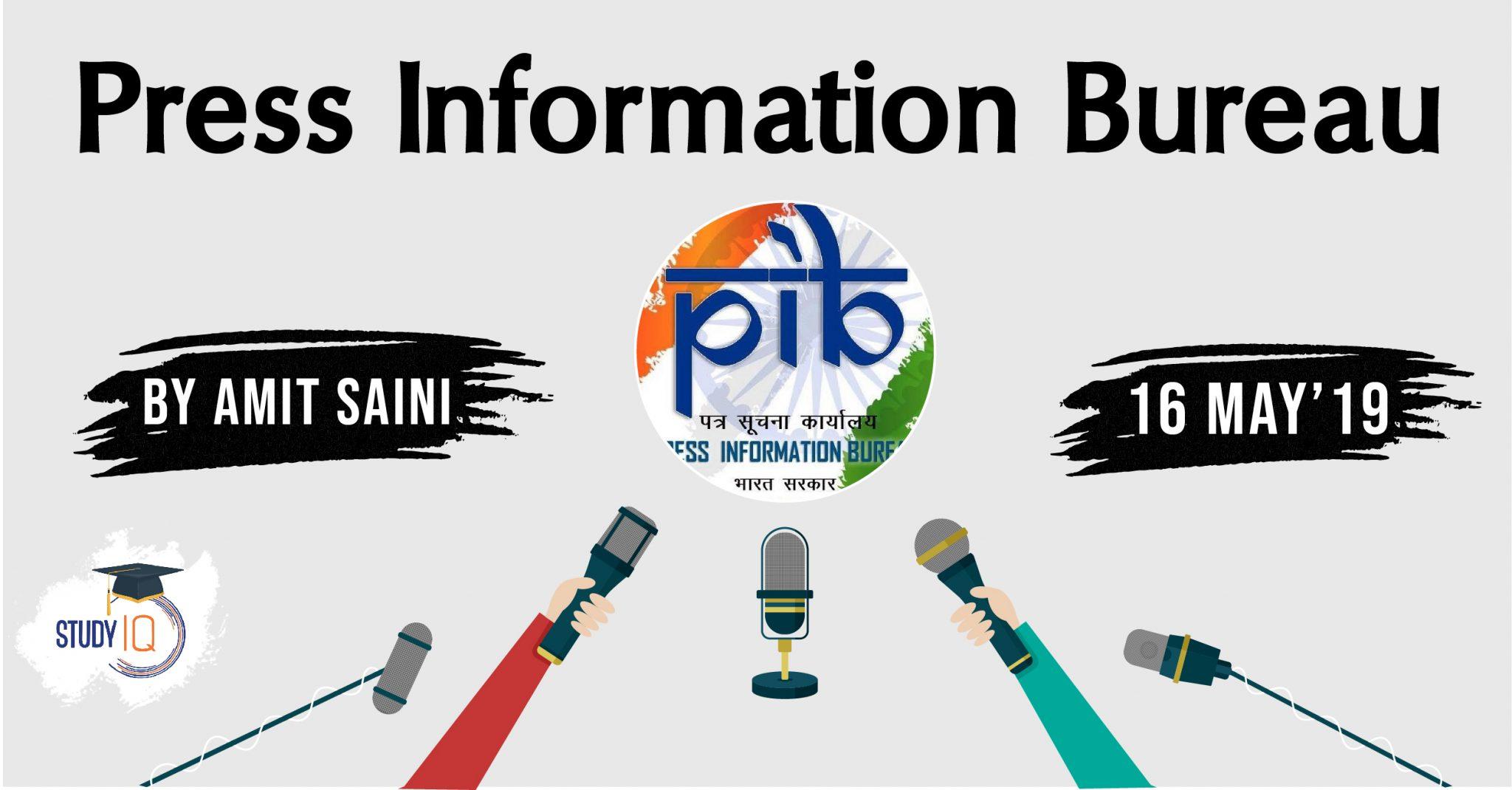

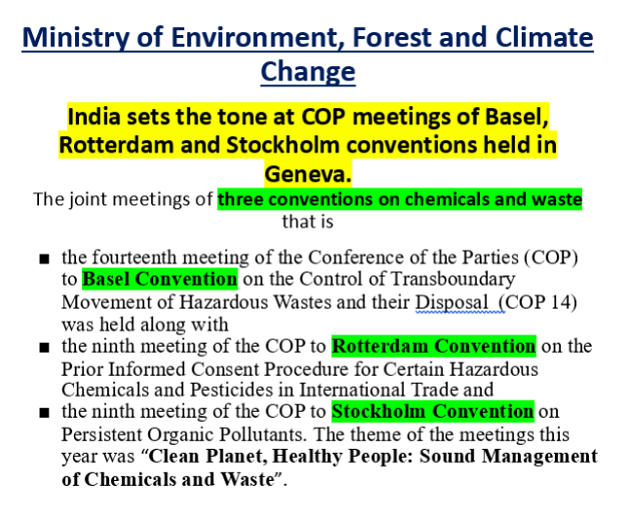



















 WhatsApp
WhatsApp